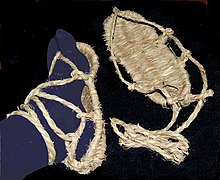


Waraji (草鞋) (IPA: [w̜aɺadʑi]) are light tie-on sandals, made from (usually straw) ropemaking fibers, that were the standard footwear of the common people in Japan.[1]



Waraji (草鞋) (IPA: [w̜aɺadʑi]) are light tie-on sandals, made from (usually straw) ropemaking fibers, that were the standard footwear of the common people in Japan.[1]

Waraji resemble other forms of traditional Japanese footwear, such as zori and geta, with a few key differences. They were historically the simplest form of outdoor footwear (sandals of any type were not worn indoors).[1] Waraji, due to their cheap and rustic nature, are considered to be a very informal type of footwear, and are not worn with formal kimono. They are typically not worn with tabi socks,[citation needed] and are woven so that the wearer's toes generally protrude slightly over the edge of the shoe.[2][1]
Waraji were once common footwear in Japan. There are records of waraji in the Heian period (794–1185 CE), with the possibility of waraji having existed before this time.[3] In the Edo period (1603–1867 CE), geta were worn in cities, but anyone making a long journey wore waraji.[4][better source needed] They were also worn for energetic or prolonged labour.[1] Their light weight and grip were valued.[5]
In modern-day Japan, waraji are worn by Buddhist monks,[2] and by some fishers of mountain streams.[5] Zori and geta are worn far more commonly by the general population.
In constant use, rice-straw waraji only last three or four days,[3] or roughly 24 hours of active use[1] and so people would have to make about a hundred pairs a year, on average, if they wore them constantly. As waraji could be homemade from cheap materials, and many people learned how to make them in childhood, that was not a problem.[3] Waraji could also be cheaply bought. Travellers carried a supply and discarded them when they were worn out.[1]
Rice straw is the common and traditional material for weaving waraji.[2] Long straw (not broken by the processing methods) must be beaten to soften the fibers before use.[6] Most other ropemaking fibers can also be used, such as cotton, hemp, palm fibers, or even strips of rag.[2][6] The straps of the waraji might be covered, often with paper.[1] Cardboard soles are used on some modern commercial designs.[7]
There are a number of different ways of tying waraji straps; even historically, there was no standardised method of attaching the shoes to one's feet.
Traditionally, waraji were donated to temples as offerings for healthy feet and protection on journeys.[8] This practice, while now less common, is still followed.[3] More modernly, giant waraji ('o-waraji') kept in temples are touched as a charm for tireless endurance in walking.[8]